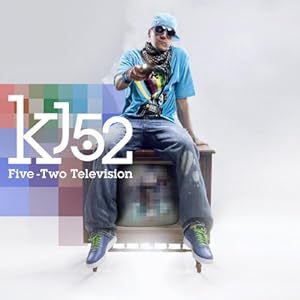
The KJ52 Five-Two cover features the lead in the group of the band, suggesting that he is the main focus of the music. From this and the way he's dressed I'd say that this was a pop group or RnB. The colours used within the picture also suggest this because they're all pretty bright like pop music albums usually are. Subsequently, I'd say that the target audience were teenagers. due to the clothing style and the colours used, bright colours usually appeal to younger audiences, but by dulling them down slightly (in this case making them lighter) lifts the target audience's age range from children to teens. I think it's not a very strong iconography itself, but it could be easily translated to other media, i.e. using light colours on a website or the artist wearing the same style of clothes in the video.

The Aesop rock cover for Bazooka Tooth features a cartoon of a boy, rather than images of the band, implying the the band is indie or alternative. The colours used are also mostly yellows, browns and greens, again a common colour scheme for indie music. From this and the more mature style of the cartoon, I'd say that the target audience were people in their late teens to mid twenties. The fact that they seem to be in school uniform doesn't change my opinions on the matter, due to the colours and style. I think it's successful at creating a brand identity
purely because of it's cartoonish style, in a similar way to the Gorillaz are famous for their cartoon alter egos and I can quite easily see them having an animated video and patterns like the wallpaper in the background.

The cover for the Tchaikovsky Collectors edition, performed by the London Philharmonic Orchestra features a photo of Tchaikovsky as the main focus, and the addition of decorative floral patterning indicates that this is a classical album. The mentions of symphonies and orchestras also helps to make this completely clear (though the Trans Siberian Orchestra's probably not the best example for mentioning orchestra related names connoting classical music.) From this I would say that the target audience is probably gender neutral, due to the mention of Romeo and Juliet, and aimed at people around 28-36 because of the grey colour scheme. I'd also say that it was people fond of Tchaikovsky's works, due to the large picture of him on the cover. I think that this could potentially be a fairly strong iconography, though it could have been stronger had it been related more to St Petersburg. But as It's probably for people that know the artist, they would probably know that he's Russian.
No comments:
Post a Comment